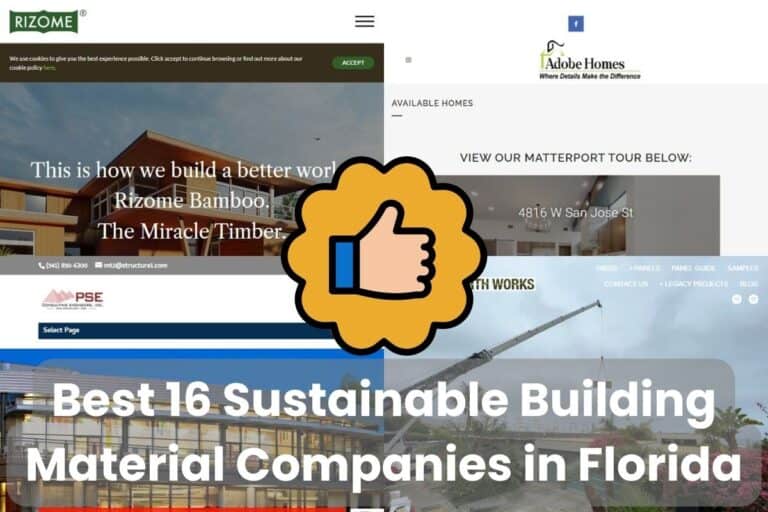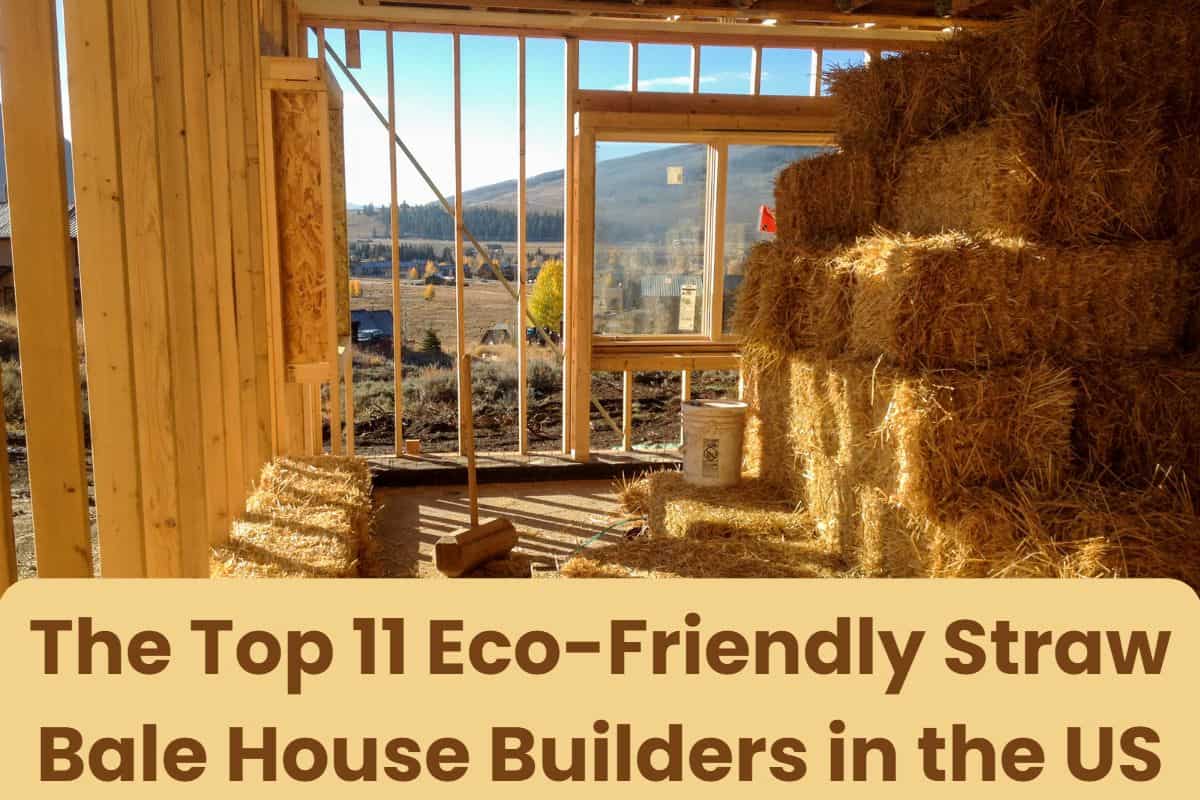Green Building Materials for Home Projects (DIY Friendly)

When I want to use green building materials for home projects, I like to source them myself. Having my builder do eco-friendly upgrades to my home is one thing. But I derive great pleasure from involving myself in the process, not least because I know that it’s being done right.
But I don’t just go buying second-hand stuff off Ebay or FaceBook Marketplace, I take the time to research which green building materials will suit my construction project.
By the end of this article, you’ll have learned what to look out for when you source and incorporate sustainable building practices into your home improvement projects. Let’s get started on how to create a greener home!
What Are Green Building Materials?

Green building materials are sustainable resources created and consumed in a manner that is environmentally conscious and resource-efficient. Examples include cork, straw, adobe, and cross-laminated timber.
We can source them from natural, renewable resources and craft the materials to reduce the ecological footprint throughout the creation, utilization, and disposal stages.
Utilizing sustainable materials is a wise decision because you can significantly decrease your carbon footprint and conserve energy, leading to cost savings on your initial build costs as well as future utility bills.
Hence, not only are you contributing to a greener future, but you also benefit financially in the present.
10 Green Building Materials for Home Projects (DIY Friendly)
Some common green building materials that you can find at Home Depot, Lowes, Amazon, and local lumber yards include:
1. Bamboo

If you’re a nature lover, you might relish the chance to live in a bamboo house. The popular building material is slowly making a comeback thanks to its environmental friendliness and versatility.
Advantages of Bamboo as a building material include the following:
- It has a unique, bohemian aesthetic that many people find appealing.
- Bamboo is a sustainable and renewable resource, making it an excellent choice for those looking to reduce their environmental impact and embrace sustainable living.
- Not only does it have a distinct look, but it’s also one of the most rapidly growing plants on earth, making it an eco-friendly choice.
- Again, it’s truly long-lasting. You may not believe it, but bamboo is stronger in some ways than steel. It can handle tension much better and withstand pressure better than concrete.
- Lastly, it is very lightweight thanks to its hollow sections. This makes it easy and affordable to transport to a construction site, saving you money during the building process.
2. Cob
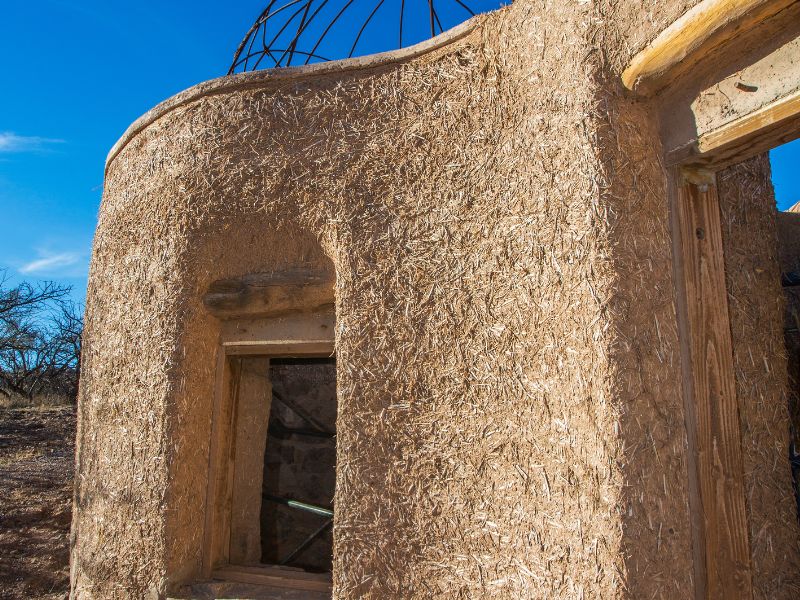
Cob is an excellent option if you’re looking to construct an environmentally friendly dwelling, and can be easily shaped to create attractive features.
- It’s a natural material that is easy to work with, even for those new to building.
- Cob combines mud and natural elements such as straw, lime, sand, and soil.
- It’s also an inexpensive option. Constructing a cob home can cost significantly less than traditional building methods, sometimes as low as one-tenth of the cost.
- The design of cob homes enables them to be energy-efficient, as they can slow down the rate of heat transfer.
Even with this, constructing a cob home may take longer than traditional building methods. Also, keep an eye on the humidity in your cob home, as this is crucial to prevent mold and its related health issues.
3. Cork
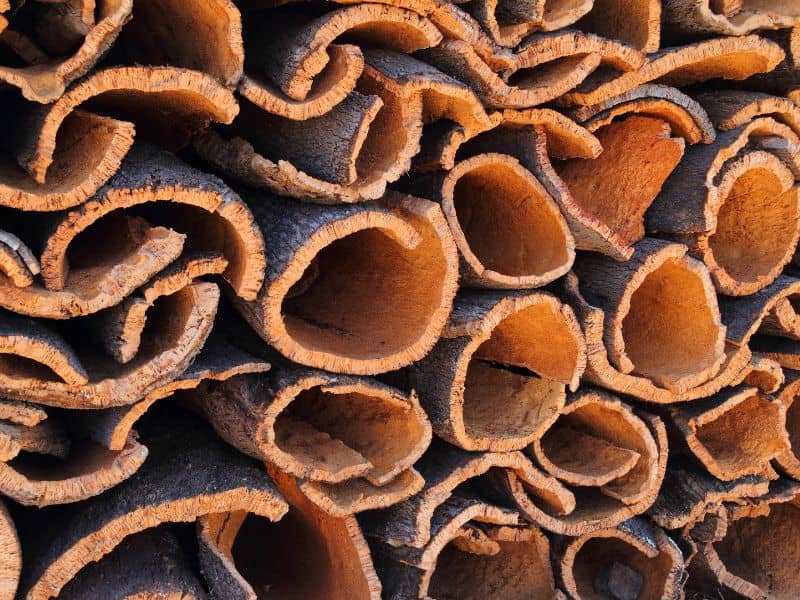
There are few greener and more sustainable building materials for your DIY project than cork. Unlike other building materials harvested from trees, cork is harvested from the bark of cork oak trees (Quercus suber). You can actually harvest it every 9-12 years without harming the tree.
So, if you thought that cork was just significant in winemaking, think again. Cork is also an efficient insulation material for home construction. Its advantages include the following:
- Cork is among the leading materials used in thermal protection globally, thanks to its unique air cushion structure. Cork’s unique cellular structure makes it naturally resistant to heat and sound, making it a great choice for walls, floors, and ceilings.
- The presence of the waxy substance suberin in the cork acts as a natural barrier, protecting cork from mold and mildew growth.
4. Stone
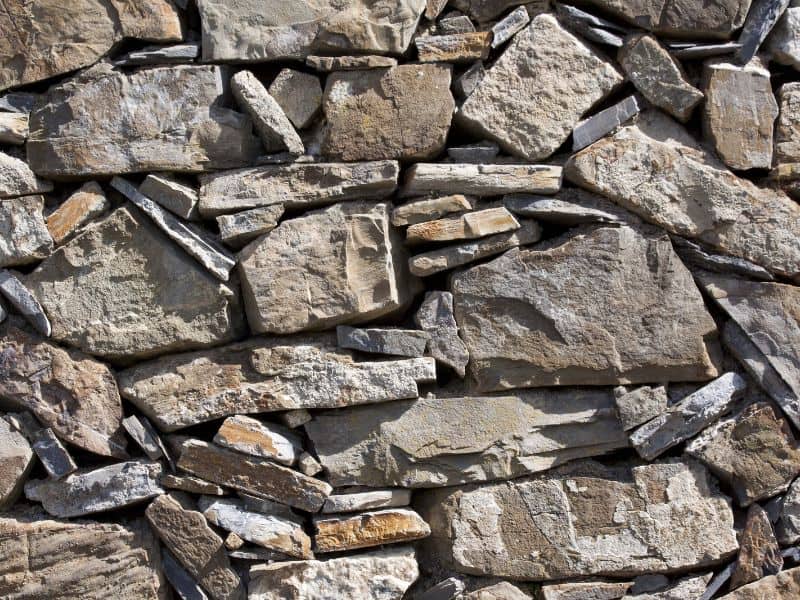
Stone structures are popular in various regions of the world, due to its abundance and suitability for construction. Stone has the following advantages as a building material.
- A rock-based building is easy to maintain and environmentally friendly. You can employ suitable surplus rock from the construction process for household embellishments like countertops or flooring.
- Building with stone also means you’ll not release harmful chemicals or toxins into the home’s interior. As it is a natural resource, no additional materials or process energy are needed to produce it.
- As a natural and long-lasting material, stone can offer many benefits to the green building sector. Stone is a tough and durable material that can withstand the test of time.
- It doesn’t rot, warp, or decay like other materials can, meaning it can last many decades without needing to be replaced.
- The upkeep and cleaning demands for stone are minimal over time, resulting in low maintenance costs for property owners.
5. Adobe brick

Adobe bricks (a mixture of clay and straw) are a sustainable building material that has been in use for centuries, and is still popular today. Often, people use it in regions like the Middle East and the Americas.
Key Features
- It offers natural insulation that helps to keep a stable temperature inside the house.
- Unconventional aesthetic: Due to the malleable nature of bricks made from dried mud, architects can experiment with distinctive forms and angles when crafting adobe homes.
- Quiet ambiance: The natural sound insulation that adobe homes provide makes them an attractive selling point, especially when the property is close to a noisy street or a bustling commercial district.
While many insurance providers for residences classify adobe homes as made of masonry construction, designating them as non-combustible, which is generally positive, obtaining insurance for adobe houses can still be complicated. This is often due to other factors like insurer unfamiliarity, susceptibility to water damage, and specialist repair needs.
6. Sheep’s Wool
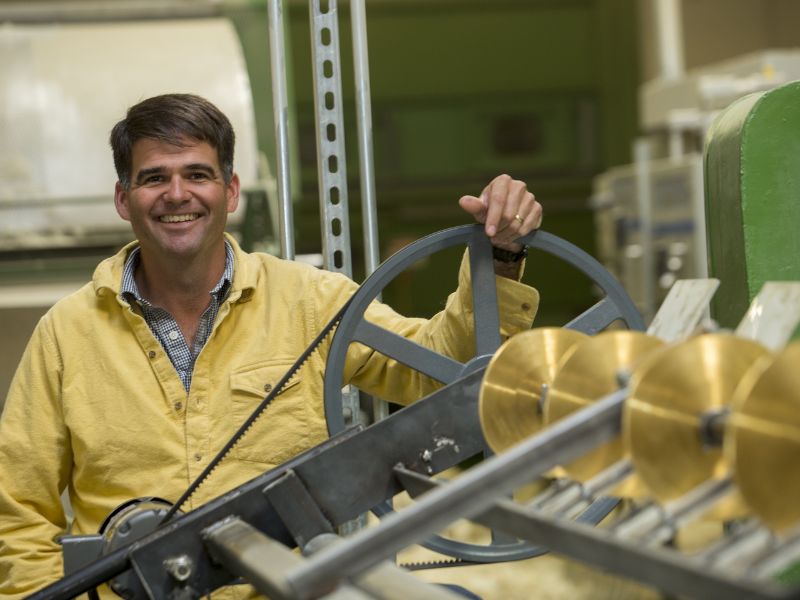
This is a sustainable and natural resource that can quickly be replenished. Most people know it for its insulating properties and often use it to produce warm blankets and sweaters.
What many don’t realize is that it can also keep homes insulated. Its fibers create numerous small pockets of air that retard the transmission of heat. Ideal for insulation ceilings, walls, and attics.
Key Features
- You can easily obtain sheep’s wool, with suppliers of sheep’s wool insulation batts, and even blown-in wool insulation expanding their reach as more people consider its use in their construction projects.
- It is a superb energy-efficient material that conserves moisture and doesn’t pollute the environment.
7. Straw Bale
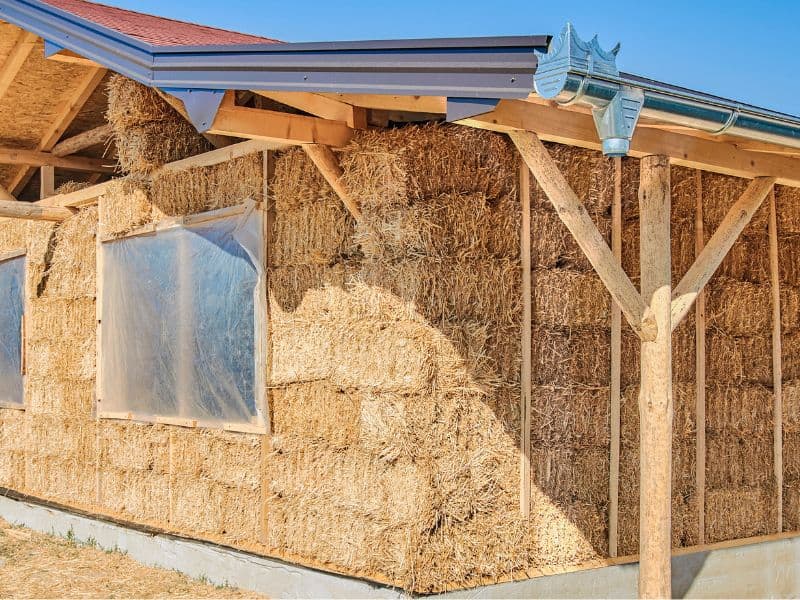
Though some may not consider it a conventional building material, you can use straw bales in construction. However, sometimes, finding an insurer to cover homes built with straw can be difficult as it can raise structural concerns, particularly if the straw bales are load-bearing.
Once completed, people use plaster to finish their straw bale homes. Compression of the bales during construction, and application of the plaster help to make straw bale homes more fire-resistant than some conventional builds.
This natural building method is cost-efficient and eco-friendly, but it could have (theoretical) potential for pests and allergens.
Key Features
- It’s economical: Due to the abundance of straw, constructing a home with this material is very cost-efficient.
- Easily replenished: Straw is bountiful on farms and in various regions across the U.S., making it even more environmentally friendly than other sources.
8. Cordwood
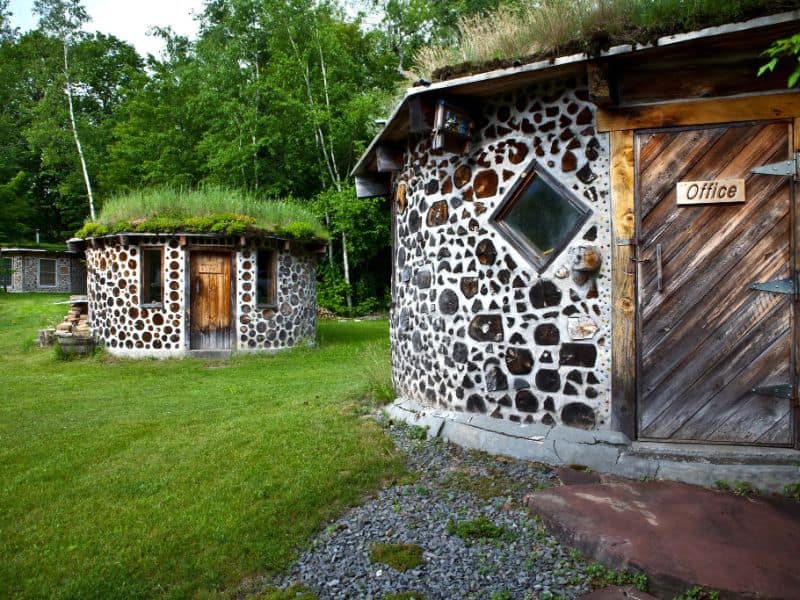
If you’re looking for a warm and inviting cottage, cordwood construction is a great option. Instead of traditional logs, this method uses chopped wood, which makes up 40-60% of the structure, combined with a mortar mixture to provide insulation.
Key Features
- Cordwood is popular for its affordability. It was trendy during the Great Depression because it was inexpensive and simple to construct.
- When constructed carefully, cordwood dwellings can have superior insulation against both warm and cold external temperatures.
- In addition, you can conveniently adjust it for designs that utilize the sun for heating.
However, while it is possible to build a cordwood home without the help of a general contractor, issues may arise when trying to obtain insurance without the proper permits.
It is essential to ensure that your home is built in compliance with masonry home requirements to avoid these issues. This will also allow you to get insurance from most insurers.
9. Ferrock
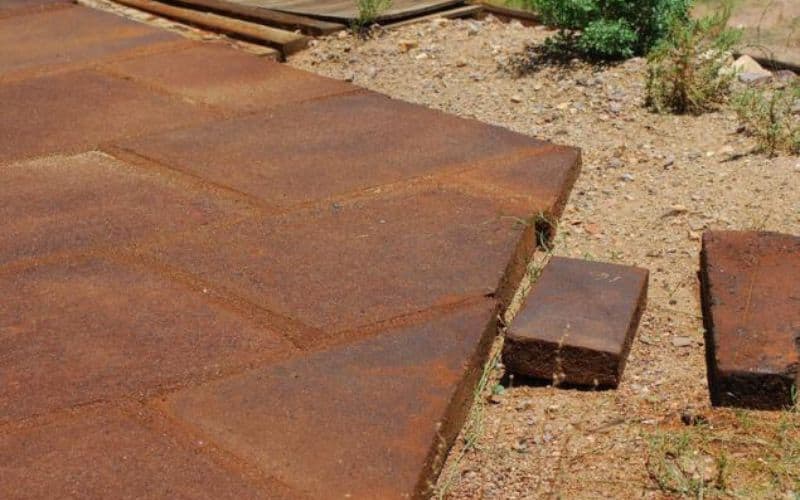
Ferrock is an innovative alternative to traditional cement-based concrete. It is rich in iron and comprises recycled materials such as waste steel dust and glass silica. Here are some of its properties and why you should consider it for your DIY construction project:
- It is an alternative to traditional cement in construction and can be used in housing. Ferrock actually absorbs carbon dioxide as it hardens, as opposed to traditional Portland cement, which releases large amounts of CO2 during its production.
- Ferrock is an exceptionally durable and robust material, particularly well-suited for marine environments such as structures exposed to seawater.
- It is significantly stronger than Portland cement and lighter than brick structures.
- Also, the process of creating Ferrock is highly sustainable.
10. Earth Bags
Earthbags, similar in design to sandbags, are filled with soil or other natural materials such as gravel, clay, or straw.
People use them as an alternative building method for homes, structures, and retaining walls. The technique involves stacking the filled bags on top of each other and compressing them to create a solid mass.
Key Features
- They are easy to produce as all you need is materials you can source locally. It is best to use soil from the local area for the natural mixture used in the bags to make these homes as environmentally friendly as possible.
- They also offer protection from temperature changes. Earthbag homes that use lightweight materials like rice husk or crushed volcanic rock to fill the bags provide natural insulation, promoting better living conditions for the inhabitants.
Insuring Your Eco-Friendly Dwelling

Finding an insurance partner to insure your eco-friendly home from the vagaries of nature and risks such as fire can sometimes be more difficult than with traditional buildings.
Here are some suggestions for securing insurance cover for your home and avoiding being at loggerheads with the insurer:
1. Consult your insurer at the planning stage, before you start work
If you plan to renovate your building to incorporate green building materials, you should inform your insurer to understand whether your approach will introduce insurance risks.
For instance, say you want to use thatch roofing, which can be more prone to fire than other materials. In this case, you should consult your insurer to establish whether they will cover fire damage.
2. Engage the insurer during renovation.
You must involve your insurer prior to renovation commencing to see if they’ll still cover your house while it’s being worked on. If not, obtain Unoccupied Home Insurance for the period or works.
3. Talk to the Insurer after renovation
Again, you must involve the insurer once the renovation is over so that they can update the building insurance policy and, if necessary, enroll you in a tailored plan.
Final Thoughts
Eco-friendly building materials are not only good for the planet but also for your home projects.
From bamboo flooring to cork insulation, the options are endless and many can be DIY-friendly. If you’re looking to upgrade your home and reduce your carbon footprint you can’t go wrong with these ten green building materials.
But don’t just limit yourself to what we’ve listed. There are loads of other green building materials available. Just choose what fits you best and Go Green!



